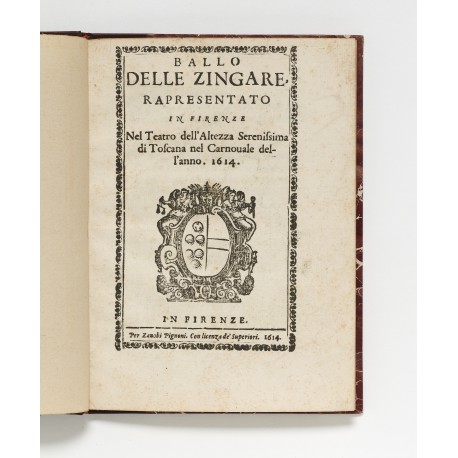 View larger
View larger
Ballo delle Zingare, rapresentato in Firenze nel teatro dell’Altezza Serenissima di Toscana nel carnouale dell’anno 1614
- Subjects
- Dance books - Early works to 1800
- Festival books and prints - Italy - Florence, 1614
- Literature, Italian - Libretti - Early works to 1800
- Authors/Creators
- Saracinelli, Ferdinando, c. 1590-1640
- Printers/Publishers
- Pignoni, Zanobi, active 1612-1643
- Owners
- Feltrinelli, Giannalisa Gianzana, 1903-1981
- Ginori Conti, Piero, principe di Trevignano, 1865-1939
- Other names
- Caccini, Francesca, 1587-1641?
- Gentileschi, Artemisia, 1593-1651/1653
Saracinelli, Ferdinando
fl. Florence 1604 – 1625
Ballo delle Zingare, rapresentato in Firenze nel teatro dell’Altezza Serenissima di Toscana nel Carnouale dell’anno. 1614.
Florence, Zanobi Pignoni, 1614
quarto (195 × 140 mm), (8) ff. signed A8; not foliated or paginated. Woodcut Medici device on title-page.
provenance prince Piero Ginori Conti (1865–1939), his exlibris1 and crowned cipher stamped in gilt on binding — Giannalisa Feltrinelli (1903–1981) — Christie’s South Kensington, ‘The Giannalisa Feltrinelli Library, Part Six’, London, 2 June 1998, lot 1270
Occasional light spotting, however a good, unwashed copy.
binding twentieth-century leather-backed boards, gilt crowned cipher gc at foot of spine.
performed as dancers (page height 196 mm)
The Ballo delle Zingare (Dance of the Gypsies) was a costumed festa da ballo performed on 24 February 1614 (stile fiorentino) in the Salone delle Commedie of the Palazzo Pitti for the entertainment of Grand Duke Cosimo ii and his wife Maria Maddalena d’Austria. The occasion was the marriage of Maddalena’s lady-in-waiting (dama) Sofia ‘Todesca’ Binestan to Cavaliere Cosimo da Castiglione, ‘provveditore di Livorno’.2 The singer-composer Francesca Caccini (1587–after 1641) composed music (now lost) to Saracinelli’s text and Agnolo Ricci’s choreography,3 and Giulio Parigi designed the sets.4
The court diarist Cesare Tinghi identifies four of the singers: Francesca Caccini, in the role of principal gypsy; Francesca’s stepmother, Margherita; a ‘Sig.ra Laura’; and a ‘Sig.ra Artemisia’, the latter possibly the painter Artemisia Gentileschi.5 Among the women dancers was another of Magdalena’s dame, Lisabetta Giraldi.6
The scene was the city of Florence and the banks of the Arno beside the Porta al Prato and Porta San Frediano. After a musical prelude, sung by Francesca Caccini, the Arno entered, joined presently by eight nymphs; while the nymphs and the Arno sang, twelve gypsies (six women and six men, one of whom was the author), costumed in gold and silver and wearing masks, sailed into port, disembarked, and descended from the stage into the hall, where the women began to dance and sing. A grand formal dance ended the evening.
Ten copies are known to the writer
● Florence, Biblioteca Moreniana, 19.17 ● Florence, Biblioteca Nazionale Centrale, Biblioteca Palatina, F.8.3.44 and C.9.5.5 (two copies)8 ● Florence, Biblioteca Riccardiana (located by Sartori) ● London, British Library, 11426.d.24 ● Naples, Biblioteca Nazionale (located by Sartori) ● New York, New York Public Library, Performing Arts – Dance, (S) *MGTZ-Res. (Ballo delle zingare) 00–3562 ● Novara, Biblioteca Riunite Civica e Negroni (located by Sartori) ● Toronto, University of Toronto Libraries, Pamphlet 217610 ● University Park, pa, Pennsylvania State University, Mary Ann O’Brian Malkin Collection, GV1643.M36 no.114 16149 ● Washington, dc, Folger Library10
The copy in the Biblioteca Moreniana, annotated with stage directions, possibly by Parigi himself, suggests that the libretto was printed in advance of the performance, to permit a rehearsal (on 8 February, according to Cesare Tinghi’s diary) with a printed script.
references Angelo Solerti, Musica, ballo e drammatica alla corte Medicea dal 1600 al 1637 (Florence 1905), pp.89–92, 355–365; Claudio Sartori, I Libretti italiani a stampa dalle origini al 1800 (Cuneo 1990), no. 3713
1. Egisto Bragaglia, Gli ex libris italiani dalle origini alla fine dell’Ottocento (Milan 1993), no. 2331.
2. Suzanne G. Cusick, Francesca Caccini at the Medici court: Music and the circulation of power (Chicago 2009), p.68, as ‘Binestan’. Sofia is elsewhere identified as ‘Sofia Maria Fildistain’; see Domenico Maria Manni, Le veglie piacevoli: ovvero notizie de’ più bizzari e giocondi uomini toscani (Florence 1815), vi, p.103. She probably was one of the seven German ladies who had accompanied Maria Maddalena from Innsbruck to Florence in 1608.
3. Warren Kirkendale, The Court Musicians in Florence (Florence 1993), p.317; Cusick, op. cit., pp.282, 297–298, 372 (note 20).
4. Arthur R. Blumenthal, Giulio Parigi’s stage designs, Garland Outstanding Dissertations in the Fine Arts (New York 1986), pp.178–180, 227 (note 129).
5. R. Ward Bissell, Artemisia Gentileschi and the authority of art: critical reading and catalogue raisonné (University Park, pa 1999), pp.21, 399 (note 16).
6. Tinghi’s manuscript diary is Florence, Biblioteca Nazionale Centrale, Ms Gino Capponi 261 (the entry for the Ballo delle Zingare occurs in volume i, ff.648–651); see Angelo Solerti, Musica, ballo e drammatica alla corte Medicea dal 1600 al 1637 (Florence 1905), pp.89–92; Cusick, op. cit., pp.282, 297–298, 361 (note 11).
7. Domenico Moreni, Bibliografia storico-ragionata della Toscana (Florence 1805), i, p.70; Il Luogo teatrale a Firenze, catalogue of an exhibition held in the Palazzo Medici Riccardi (Florence 1975), p.147 no. 10:13.
8. Latter copy exhibited ‘Per un regale evento’: spettacoli nuziali e opera in musica alla corte dei Medici, catalogue of an exhibition held in the Biblioteca nazionale centrale, edited by Maria Adelaide Bartoli Bacherini (Florence 2000), p.225 no. 153.
9. The art of Terpsichore: from Renaissance festivals to Romantic ballets; an exhibition of dance-related rare books and prints, catalogue by Madison U. Sowell (Provo, ut 1994), no. 14; Mary Ann O'Brian Malkin, Dancing by the book: a catalogue of books 1531–1804 in the collection of Mary Ann O’Brian Malkin (New York 2003), no. 114.
10. Louise Clubb, Italian plays (1500–1700) in the Folger Library (Florence 1968), no. 761.



